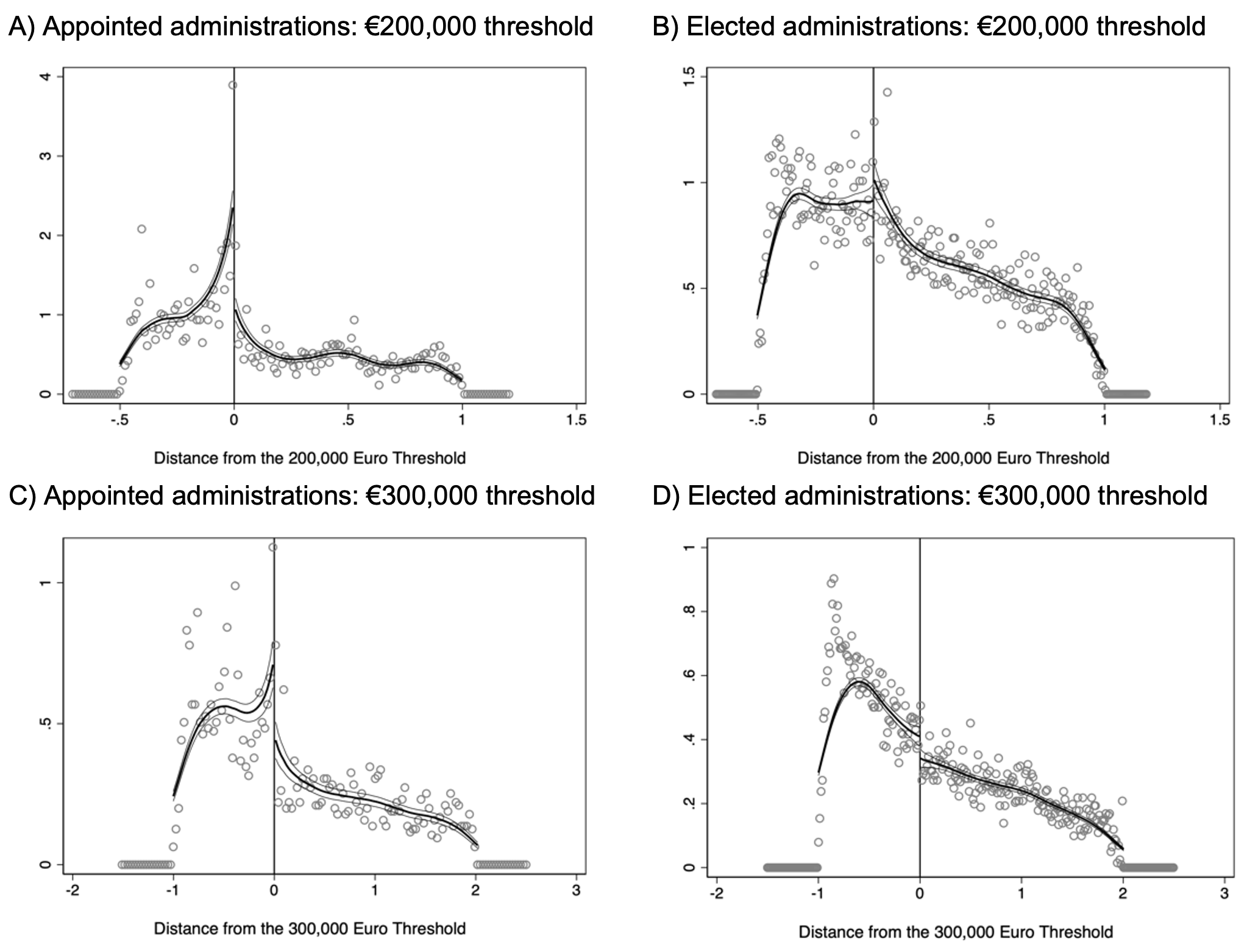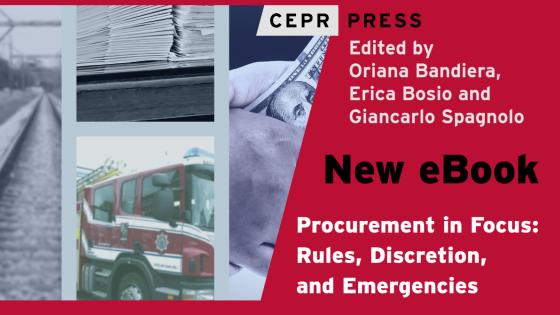Governments around the world regularly procure a large amount of goods, services, and public works from private suppliers, some of which are crucial to social welfare and economic growth. Positioned at the intersection of government and the private sector, public procurement is at considerable risk of corruption and so is highly regulated. Rules typically limit public buyers’ discretion in the awarding of contracts and become more stringent when these exceed certain value thresholds.
On the other hand, rules limiting bureaucrats’ discretion come at the cost of not allowing them to perform effectively, so the amount of rules and discretion should trade off the benefit of preventing corruption with the cost of poor administrative performance (Banfield 1975, Kelman 1990). Recent economic research on procurement has finally recognised these two contrasting roles of discretion: not only its well-known role in facilitating corruption (Rose-Ackerman 1999, Di Tella and Schargrodsky 2003), but also its role in improving performance in a world of contractual incompleteness and imperfect enforcement (Spagnolo 2012, Coviello et al. 2016, 2018, Decarolis et al. 2020b, Bandiera et al. 2021a, 2021b, Parry et al. 2020, Coviello et al. 2021). Beneficial and detrimental uses of discretion typically coexist, so that who does what and which of the two effects dominates are empirical questions. Indeed, one of the main findings of the cross-country comparison of procurement laws, practices, and outcomes by Bosio et al. (2020a, 2020b) is that rules and discretion may have very different effects in different institutional environments.
In a new paper (Coviello et al. 2022), we examine how and by whom ‘illegal’ discretion – obtained through unlawful manipulations of contract values – is used in public procurement, and with what consequences in terms of final procurement outcomes.
To address our research questions, we leverage a large sample of Italian procurement data to study the effects of contract value manipulation (bunching) to avoid crossing thresholds in procurement legislation that reduce the discretion available to contracting authorities. Italy is a particularly interesting environment to study. Bosio et al. (2020a, 2020b) find that it is among the most strictly regulated countries in the world (much more than other countries with similarly high levels of human capital) and that – possibly for this reason – it ranks relatively low in terms of procurement quality. Manipulation to circumvent such strict rules might then provide benefits in terms of improved procurement quality, alongside an increase in potential abuses, in a country with relatively high levels of (perceived) corruption.
Bunching below procurement thresholds has been studied before by Palguta and Pertold (2017), Szucs (2020), and Carril (2021) for discretion-reducing rules in the Czech Republic, Hungary, and the US, respectively. To the best of our knowledge, our paper is the first that aims to answer the question of who bunches and why, thereby also relating to the literature on the important role of public buyers’ characteristics in determining procurement outcomes (Bandiera et al. 2009, Best et al. 2017, Bucciol et al. 2020, Decarolis et al. 2018, 2020a, 2021).
Our data cover the period between 2000 and 2005, when Italian public administrations were subject to the same national procurement law. Below certain thresholds in the value of procurement, this law allowed a more extensive use of discretionary procedures, such as auctions restricted to invited bidders, leaving administrations free to decide who (not) to invite to bid. The data include information on public works from approximately 10,000 administrations, encompassing not only standard procurement outcomes (i.e. number of bidders, winner, and discounts), but also ex-post outcomes such as the duration of public works, delays from contractual deadlines, and cost overruns from the price determined during the auction. We match these data with information on the political characteristics of public administrations and with a dataset that contains balance sheet information on suppliers, including financial default risk.
Figure 1 shows the results of manipulation tests for the four main types of contracting authorities in our sample. We document extensive bunching just below two discretion-reducing thresholds and find that this effect primarily concerns public administrations whose officials are appointed by the government (henceforth, ‘appointed administrations’), such as ministries and the road authority. Bunching disappears when the officials within an administration are directly elected (henceforth, ‘elected administrations’), such as municipalities and provinces. This evidence is comparable to the one we obtain with bunching estimators. Further, we formally verify that manipulation is predominant in appointed administrations but muted in elected administrations, using machine learning analysis and controlling for other observable characteristics. We interpret our findings as suggestive that electoral accountability may prevent elected administrations from circumventing procedural rules by manipulating the value of contracts.
We then estimate the effects of manipulation on discretion and procurement outcomes and the effects of manipulation-induced discretion on outcomes for appointed administrations, using the technique developed by Diamond and Persson (2016). We find that manipulation has a positive impact on the use of discretionary procedures by reducing the number of bids and with mixed effects on rebates depending on the threshold (our data includes two discretion-reducing thresholds). Regarding ex-post outcomes, manipulation has consistently positive effects: for both thresholds, it reduces the total duration of works, delays in project delivery, and cost overruns.
Figure 1 Manipulation tests around the thresholds for appointed and elected administrations
Note: The figure shows discontinuity tests of the value of the project around the €200,000 and the €300,000 thresholds, separately for appointed and elected administrations. In each panel, the running variable is the difference between the reserve price and the threshold (vertical line); circles are average observed values; the bold, solid line is a kernel estimate (see McCrary 2008); and the two thin lines are 95% confidence intervals. The evidence suggests that the null hypothesis of no sorting is rejected at standard statistical confidence levels at both thresholds only for appointed administrations only.
When we look at the characteristics of selected suppliers, we find that it reduces the likelihood that a winner is (ex-ante) financially risky with no impact on their productivity. Finally, we find that manipulation increases incumbency, measured by repeated awards to the same suppliers. This suggests that one way manipulation improves outcomes may be by using discretion to select or establish relationships with less risky and better-performing suppliers, perhaps at the cost of more expensive procurement.
Our results are confirmed by machine learning analysis and are robust to standard variations of the bunching methods. Additionally, we cross-validate our main estimates using a unique quasi-experiment determined by a 2006 procurement reform that shifted the discretion thresholds. We find that administrations quickly adjust to the new rules, but heterogeneously based on how administrators are selected in office: appointed administrations are those that react to the reform, whereas the response of elected administrations is more muted.
In sum, our findings are coherent with appointed administrations violating procedural rules to manipulate the value of contracts to retain discretion, and use it often enough to establish repeated interactions with less risky and better-performing suppliers, so that on average procurement outcomes improve. Conversely, we find no manipulation (and poorer procurement outcomes) for elected administrations, possibly due to stronger electoral discipline.
We interpret our findings through the lens of a simple model of procurement that extends the model in Bosio et al. (2020a, 2020b) by introducing the possibility for procuring administrations to manipulate the value of contracts and to obtain discretion at a cost that may depend on electoral incentives. The model has multiple equilibria, two of which predict efficient manipulation (improved procurement performance) and incumbency – one with bribes and one without. Our empirical results are compatible with both equilibria. They should therefore be interpreted as an average among these coexisting cases, dominating those with inefficient manipulation.
In a broader sense, our results indicate that accounting for the heterogeneity across government agencies is important for a full understanding of bureaucratic behaviour. They are therefore in line with Bandiera et al. (2009), who show that excessive regulation, red tape, and bureaucratic inefficiency are more significant sources of waste than corruption in Italy, and that more autonomous administrations have better procurement processes and are less corrupt. They also support the conclusion of Bosio et al. (2020a, 2020b), that looking at the laws without accounting for the practice does not allow a full understanding of the effects of regulation, and that in high human capital countries, fewer rules constraining bureaucratic discretion or a looser enforcement of these rules would likely be beneficial.
References
Bandiera, O, A Prat and T Valletti (2009), “Active and Passive Waste in Government Spending: Evidence from a Policy Experiment”, American Economic Review 99(4): 1278-1308.
Bandiera, O, M C Best, A Q Khan and A Prat (2021a), “The Allocation of Authority in Organizations: A Field Experiment with Bureaucrats”, The Quarterly Journal of Economics 136(4): 2195-2242.
Bandiera, O, E Bosio and G Spagnolo (2021b), “Discretion, efficiency, and abuse in public procurement: A new eBook”, VoxEU.org, 30 November.
Banfield, E C (1975), “Corruption as a Feature of Governmental Organization”, Journal of Law and Economics 18(3): 587-605.
Best, M C, J Hjort and D Szakonyi (2017), “Individuals and Organizations as Sources of State Effectiveness”, NBER Working Paper No. 23350.
Bosio, E, S Djankov, E L Glaeser and A Shleifer (2020a), “Public Procurement in Law and Practice”, NBER Working Paper No. 27188, forthcoming in the American Economic Review.
Bosio, E, S Djankov, E Glaeser and A Shleifer (2020b), “Corruption in public procurement”, VoxEU.org, 5 November.
Bucciol, A, R Camboni and P Valbonesi (2020), “Purchasing medical devices: The role of buyer competence and discretion”, Journal of Health Economics 74: 65-81.
Carril, R (2021), “Rules versus discretion in public procurement”, Economics Working Papers 1765, Department of Economics and Business, Universitat Pompeu Fabra.
Coviello, D, A Guglielmo and G Spagnolo (2016), “The effect of discretion on procurement performance: Efficiency versus corruption”, VoxEU.org, 7 August.
Coviello, D, A Guglielmo and G Spagnolo (2018), “The Effect of Discretion on Procurement Performance”, Management Science 64(2): 715-738.
Coviello, D, C Lotti and G Spagnolo (2021), “Rules, bunching and discretion in emergency procurement: Evidence from an earthquake”, in O Bandiera, E Bosio and G Spagnolo (eds.), Procurement in Focus: Rules, Discretion, and Emergencies, CEPR Press.
Coviello, D, A Guglielmo, C Lotti and G Spagnolo (2022), “Procurement with Manipulation”, CEPR Discussion Paper No. 17063.
Decarolis, F, L M Giuffrida, E Iossa, V Mollisi and G Spagnolo (2018), “The (large) impact of buyer competence on the cost and timing of procurement”, VoxEU.org, 31 May.
Decarolis, F, L M Giuffrida, E Iossa, V Mollisi and G Spagnolo (2020a), “Bureaucratic Competence and Procurement Outcomes”, The Journal of Law, Economics, and Organization 36(3): 537-597.
Decarolis, F, R J Fisman, P Pinotti and S Vannutelli (2020b), “Rules, Discretion, and Corruption in Procurement: Evidence from Italian Government Contracting”, NBER Working Paper No. 28209.
Decarolis, F, G de Rassenfosse, L M Giuffrida, E Iossa, V Mollisi, E Raiteri and G Spagnolo (2021), “Buyers’ role in innovation procurement: Evidence from US military RD contracts”, Journal of Economics Management Strategy 30(4): 697-720.
Diamond, R and P Persson (2016), “The Long-term Consequences of Teacher Discretion in Grading of High-stakes Tests”, NBER Working Paper No. 22207.
Di Tella, R and E Schargrodsky (2003), “The Role of Wages and Auditing during a Crackdown on Corruption in the City of Buenos Aires”, The Journal of Law & Economics 46(1): 269-292.
Kelman, S (1990), Procurement and Public Management: The Fear of Discretion and the Quality of Government Performance, AEI Press.
McCrary, J (2008), “Manipulation of the running variable in the regression discontinuity design: A density test”, Journal of Econometrics 142(2): 698-714.
Palguta, J and F Pertold (2017), “Manipulation of Procurement Contracts: Evidence from the Introduction of Discretionary Thresholds”, American Economic Journal: Economic Policy 9(2): 293-315.
Parry, K, O Bandiera, M Best, A Khan and A Prat (2020), “Autonomy – not rules – may be the government’s best weapon in the fight against corruption”, VoxEU.org, 13 May.
Rose-Ackerman, S (1999), Corruption and Government: Causes, Consequences, and Reform, Cambridge University Press.
Spagnolo, G (2012), “Reputation, Competition, and Entry in Procurement”, International Journal of Industrial Organization 30(3): 291-296
Szucs, F (2020), “Discretion and favoritism in public procurement”, Job market paper.








